Users have a variety of hay rakes to chose from, but dealers must know what users are aiming for to help them select the proper one.
“If money were no object, what I tell people who come into the dealership with questions about which rake is best for producing quality hay is they need about three different rakes to have the right one on any given day,” says Ryan Parker of Parker & Sons Equipment in Claypool, Ind.
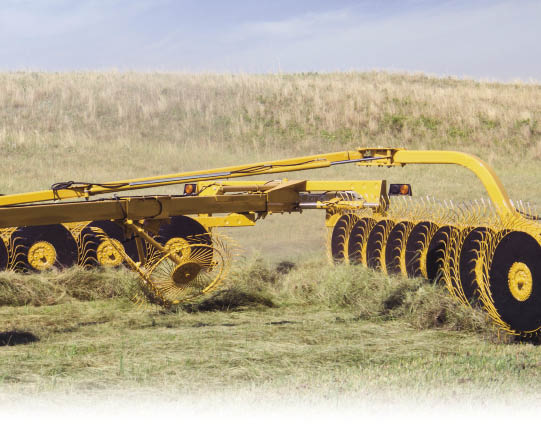
A center splitter on the wheel rake splits the windrow evenly producing a nice, even windrow when its pulled back together. Photo courtesy of Vermeer
In addition to operating a shortline equipment dealership, Parker says his family also produces a lot of hay. “I know there have been days when I’ve got a rake in the field and wish I had another one or different one.
“To simply combine two windrows and move them the least amount of distance, a center delivery rakes work great,” says Parker. “Then you could use a tandem side-delivery rotary rake for light or tedded-out crop to put multiple windrows together for baling. But there are times when you just need to roll that windrow, so you could use a single rotary rake.
“We have as big an advantage over anyone because typically we could have all three rakes on the lot at the same time,” but he says, “We try to keep one rake on the farm and use it throughout the season.”
Parker says he has yet to get anyone to bite on his proposal that they buy three different rakes to cover different haying situations. And while he prefers a rotary rake overall, he says the other styles have their place and more often then not, the choice comes down to preference and operator knowledge and ability.
The one thing that is constant, though, is that the hay rake plays a critical role in producing quality forage with a high nutritive value.
The Hay Rake’s Role
According to Bruce Shannon of Nikkel Iron Works, which produces the Darf hay rake line, “The raking step is sometimes taken for granted in the production of quality hay, but how a rake handles the hay can materially impact efficiency and forage quality.”
In their report, “Equipment to Rake and Merge Hay and Forage,” K.J. Shinners and R.T. Schuler, professors in the Biological Systems Engineering Dept. at the Univ. of Wisconsin-Madison, say that rakes are used for one or more of four purposes:
- To invert the crop to allow wet hay on the bottom of the swath to be exposed to sun and wind;
- To displace the swath from wet to dry ground;
- To merge swaths together to match the windrow density with harvester or baler capacity;
- To narrow the swath into a windrow narrow enough to meet the width of the harvester or baler pick-up.
In North America, three distinct types of hay rakes are typically used for hay and forage operations. These include wheel rakes, rotary rakes and parallel bar or basket rakes. Hay or windrow mergers are growing in use in operations where the very large forage harvesters or choppers are utilized. Compared to the other hay rake types, mergers are easily more costly to purchase and for the purposes of this article will not be covered here. (For more information on mergers, please see “Combining Productivity, Quality Creates Niche for Hay Mergers,” Dave Kanicki, April/May 2010, Farm Equipment.)
Wheel Rakes for Custom Producers
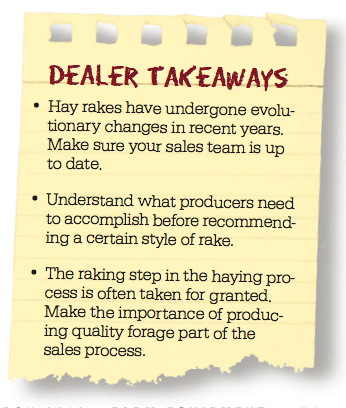
Shannon says the large hay producers he works with look most closely at the angle of the wheel rake and its ability to create a fluffed-up windrow. “The fluffing creates a condition in which the air can reach the hay so it will dry faster, so it can be baled more quickly. Getting the hay baled a day or two sooner also helps prevent yellowing,” he says.
Listening to veteran California custom producers Stan Azevedo of Azevedo Custom Hay, and Mike McCurdy of Precision Hay Co., has resulted in the most recent design changes to Darf’s newest generation of wheel rakes.
“If the rake wheel is designed to lift the crop into the air as it hits, compared to laying it back more, the hay will cure better and it will roll more tightly and curl less,” says McCurdy. “The whole point is to get it up faster so the farmer can get the water back on and get the next crop coming.”
McCurdy also emphasizes the critical timing of raking, and the many variables that can impact a schedule. “A lot of people don’t understand how important the timeframe is in terms of raking. Different ground conditions will affect the timing. Sandy soil dries faster and heavy soils hold the moisture so hay will take longer to cure. Newer hay vs. older hay makes a big difference.”
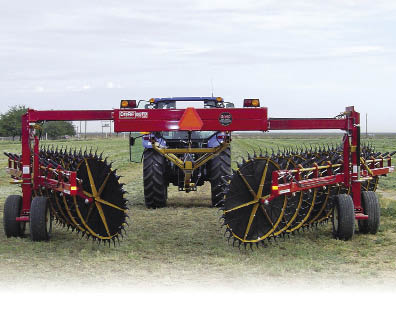
The angle of the wheel and its ability to create a fluffed-up windrow is the key to effective hay raking. Photo courtesy of Vermeer
He adds that sticking to a pre-determined schedule doesn’t always work in the custom hay harvesting business, but getting through the field quickly, while handling the hay gently is as important as a rake’s ability to fluff or aerate the hay.
“A crop-driven rake, with the wheels all spinning, barely touches the crop on the ground so it is more gentle and there is less chance of losing the leaves, which is where the nutrition is,” Azevedo says.
The nutritional value of hay is linked to good harvest practices, which can help ensure that the hay has the right dry matter content and that it will ferment properly to preserve the nutrients.
Azevedo points to changes in rake design that have allowed him to work his rakes at 13 mph, compared to the previous 4-5 mph. And, a wheel rake allows him to rake when the hay is on the drier side, which helps with baling, and even when the hay is a little too damp.
“I’ve been involved in testing wheel rakes for 25 years, helping manufacturers develop a gentle rake. We have seen rakes evolve and the design improve and the end result is that today we can efficiently provide quality forage. In today’s world, I can’t afford four rakes doing 4,000 acres a month. I need to do 400 acres a day and I have to be efficient or I would need six or seven rakes. More equipment means more men and more maintenance. I have to be efficient to stay in business.
“A good rake is one aspect of my operation that has really improved efficiency. With a gentle, wheeled rake, I can go from cutting to baling in just three days and deliver nutritious, quality hay,” says Azevedo.
Continuing Refinements
According to Philip Egging of Vermeer, for all of its advantages of speed and simplicity, the wheel rake has been in need of additional development from a performance standpoint. He says Vermeer has continued to improve the capability of its rakes by adding individual lift cylinders to each rake wheel. In Vermeer’s case, the lift cylinders are plumbed in-line with a nitrogen accumulator.
What this accomplishes, according to Egging, is it provides for equal weight of that wheel on the ground through the full range of motion of the rake wheel. He says this means, “There’s a better chance of setting an optimal ground pressure and it’s not going to gouge the ground as the rake goes over undulations or uneven terrain in the field and it won’t miss material either. This reduces the amount of dirt, debris and rocks that is raked into the windrow, resulting in better quality material.”
The new wheel rakes are getting larger, too. At the National Farm Machinery Show in Louisville last month, Vermeer displayed its new 20 wheel model. “This is another advantage of the wheel rake,” says Egging. “You can easily add additional wheels and have a rakes that covers 40-plus feet in a single pass.”
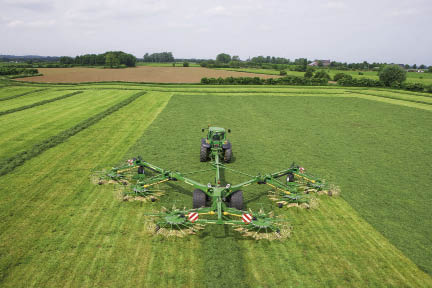
To keep the biggest forage harvesters running at full speed, rotary rakes that cover up to 60 feet have been developed. Photo courtesy of Krone
The company also showed its center splitter option at NFMS this year. “The center splitter has been on rakes probably since the invention of the rake. But the new design has two larger wheels that are dished and angled down. The advantage of this is they’re full sized wheels so they don’t have a tendency to wrap and we’re splitting the windrow evenly out either side so you have a nice even windrow when you pull it back together. And the way that they’re dished and angled they sweep the full width, up to about 48 inches across. It’s done very well for us out in the field,” says Egging.
A Comeback for the Basket Rake?
In their paper, Shinners and Schuler maintain that while parallel-bar rakes were the dominant machines used to manipulate forage crops in the Upper Midwest for many years, sales of these machines have been declining.
On the other hand, Al Henneman who has been selling equipment for Evergreen Implement in Othello, Wash., for 42 years, says a new seven-bar basket rake has become the rake of choice for many of his customers in recent years.
He says there’s a big push for higher quality hay in the region because much of it is exported in big square bales to overseas markets, including Japan and Korea.
“We need a rake that is gentle on the hay so it doesn’t knock the leaves off and it must make the windrow fluffy enough so that air can get through it and it can dry. They have to have it dry in the big bales so it doesn’t mold,” says Henneman.
He estimates he sells 10 times the number of basket rakes compared with any other type of rake in his region.
In operation, he says the baskets are tipped back slightly to lift the hay instead of sliding along the ground. “It lifts it up and keeps it all together while pulling two windrows together. This helps keep the hay so it doesn’t blow around.”
Henneman says that one of the best things that have happened to basket rakes is the development of the seven bar rake and large diameter basket with larger frame that’s been introduced by Northstar. “This has really been a significant upgrade in making the rake far better than it used to be. It handles the hay much more gently, and with the seven bars you can turn the basket probably 20-30% slower and keep the same ground speed.” He estimates that speed to be in the 10 mph range, but says it varies with the grower.
A grower from Stockton, Calif., explains that the seven bar design is far more versatile that the previous five bar rake. “The seven bar design rolls and lays the hay out better than earlier models,” he says. “I get better raking at a wide angle. We windrow with 14 foot headers and the wider angle allows me to rake two windrows together and then come back and rake those two together. I can rake faster with seven bars than five.”
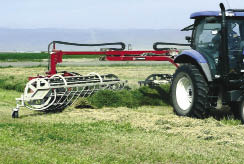
The seven-bar basket rake is becoming the choice of many of the largest hay producers in the Northwestern U.S. Photo courtesy of Northstar
He adds that the heavier frame also allows him to get better “fore and aft tilt” when he needs it and the basket stays level. “If the basket is level, I get less dirt pickup and a cleaner windrow.”
Dave Rankin, who developed the seven bar rake, says producers can also adjust the windrow from the standpoint of making it tighter or looser. He explains the 27 and 30 foot models have a parallel linkage that attaches from the rake frame to the basket. “If you extend the top links, the top of the basket extends outward and that creates a tighter windrow. For a fluffier windrow, tightening the top links tilts the basket backward creating a looser windrow.”
Rotary Rakes Continue to Expand
According to Jody McRee of Krone North American, the total North American market for rotary rakes grew 5% from 2011 to 2012. But it’s not only the sales volume of rotary style rakes that continue to grow.
“Larger working width rakes are becoming more popular,” says McRee. “We introduced a six rotor rake with a working width of 60 feet. We see this large rake running mostly in front of self-propelled forage harvesters.”
Ryan Parker of Parker & Sons Equipment says this is the most significant trend when it comes to rotary units. “We’re selling a lot more tandem rotary rakes and triple and even quad rotary rakes in the past few years,” he says.
McRee also notes that more dry hay producers are considering this type of rake in their quest for higher quality hay. “Our horse hay producers tell us that there is less debris (dust and dirt) in the windrow, and the hay is able to dry down very well in the windrow. They also tell us that it’s easier to bale behind a rotary rake.”
The use of Krone’s SW810 rake is growing with commercial dry hay producers, he says, because it has the capability of making one or two windrows in one pass with working widths of 22-24 feet. “They’re utilizing one windrow for lighter crops and two windrows for those fortunate enough to have heavy crops,” says McRee.
Parker, who is also a producer, believes that use of rotary rakes is growing in his area in Indiana because of its ability to rake a little tougher crop. “We can maintain a good quality of hay because it keeps more leaves with less damage.
“It also allows you to rake a tougher crop because of how it leaves the windrow,” says Parker. “It discharges even wet hay into a high fluffy windrow which allows air to pass through it and dry out before baling.”
He says producers who chop or wet bale are increasingly using rotary rakes because the newer, larger units can handle the weight of the crop. “It really works well when raking 30-40 foot swath of hay into a single windrow. You can’t really use a wheel rake because the rake tines aren’t strong enough to keep the crop cleaned off the ground.”






